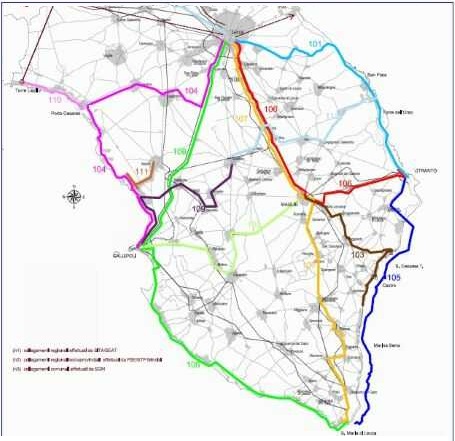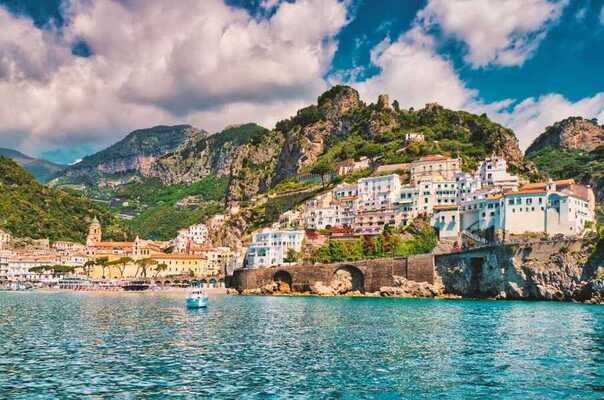The 7 unmissable places in Puglia
Once upon a time, Salento was a land of conquest. Today it is one of the most desired destinations for the summer and every tourists leave a piece of their heart here. On the other hand, just seeing her sea is enough to fall in love with her. Salento is a magical, eclectic and, sometimes, surreal place that manages to enchant and bewitch with its coasts, its breathtaking landscapes, its history and the typical culture of the “Heel of Italy”. The warmth and hospitality of the places and the people transform the stay into an unforgettable experience. In this article we will list the 7 unmissable places that cannot be missed during your holidays in Puglia!
1. Ostuni, the “White City”

The magic of Ostuni, known as the “White City”, is linked to the characteristic lime paint coloring of the ancient village
Worth visiting, in the heart of the ancient village, are the Romanesque-Gothic style Cathedral, the former Carmelite monastery home to the Museum of Preclassical Civilizations of the Southern Murgia, the church of San Francesco, the Co-Cathedral and above all the ancient village. While outside the town the ancient farms deserve attention: among others, Santa Caterina with the high octagonal tower, the fortified masseria “Lo Spagnulo” (farm) and the Cappuccini masseria with its trulli.
Walks, workshops and tastings at the numerous educational farms, i.e. agritourism companies distributed throughout the territory which offer, for schools, but not only, direct experiences of observation and study, and then manipulations, fruit harvesting, participation in the various phases of transformation of agricultural products, creation of small rattan objects and tasting of typical products.
Finally, a visit to the Castellana Caves is a must, open all year round and is carried out with the help of expert tourist guides.
2. Itria Valley

It may be due to the white of the buildings or the vegetation that frames them, but every town, every village in the valley is surrounded by a magical, almost fairy-tale atmosphere. Valle d’Itria also called «Valle dei Trulli», is an extensive valley dotted with the famous cylindrical-shaped houses.
In the heart of the Itria Valley, an obligatory stop is Alberobello with its trulli, a location included in the UNESCO World Heritage List and is considered a unique and enchanting place and, although it may be a little too touristy, it certainly deserves a visit visit. Most of the trulli here have been transformed into souvenir shops, cafes, restaurants, but some (in the less crowded areas of the city) are still inhabited. It’s impossible not to be fascinated by a walk through the streets of the Monti and Aja Piccola districts. Furthermore, here among the trulli, both the Living Nativity Scene, in the month of December, and the Living Passion, during the Easter period, are staged.
In the valley there is not only Alberobello. Its countryside is dotted with these typical buildings: just think of Cisternino, which rises in the so-called Murgia dei trulli, counted, together with nearby Locorotondo, among the most beautiful villages in Italy. The latter, called “Luogorotondo” until the mid-nineteenth century due to the characteristic round shape of the town, is part of “La Terra dei Trulli”.
3. The Torre Guaceto Nature Reserve
The Torre Guaceto Nature Reserve is a protected area located in the territory of Carovigno, on the Adriatic coast, a beach awarded with the 3 Sails of Legambiente. This stretch of coast is 6 kilometers long and offers an uncontaminated Mediterranean landscape, with the sea and dunes, Mediterranean scrub and marshes, of particular importance, as well as beauty. Inside there are habitats and landscapes such as a marine reserve with rocky and sandy seabeds, a wetland populated by amphibians and birds, high sand dunes and long accessible beaches where you can swim in a unique context. Throughout the year, the reserve offers numerous sporting activities such as trekking, cycle trekking, snorkeling and seawatching and various environmental education initiatives. The symbol of the area is the mighty Aragonese tower which for centuries has peered over the wonderful sea it overlooks.
4. Specchia
Specchia was the first of the Salento villages to earn the title of one of the most beautiful villages in Italy. The town is located in the Salento hinterland, behind Leuca, between Ugento and Tricase. It stands on a modest hill, perhaps justifying its name: the “specchie”, in fact, were piles of stones that the Messapians created as watchtowers. The center of the village is very enjoyable, with cars banned for some time and the possibility of walking and discovering its beauties. Typically medieval, with Catalan and Baroque motifs and decorations, Specchia is the town where life flows slowly.
The most evocative part of the center is the one behind the sixteenth-century Palazzo Risolo, among the tangle of alleys, courtyards and short stairways. Standing out with all its grandeur on Piazza del Popolo are the Ripa palace, the underground oil mills, the convent of the Black Franciscans dating back to the 15th and 16th centuries and the church of Santa Caterina. There are also several caves that open along the beautiful and very high limestone walls of this stretch of coast, which falls within the territory of the Costa Otranto, Santa Maria di Leuca and Bosco di Tricase Park.
5. Porto Selvaggio
You can immerse yourself in the extraordinary environment of the Regional Park of Porto Selvaggio and Palude del Capitano, included by the FAI (Fondo per l’Ambiente Italiano) among the 100 places to be saved, a green treasure on the blue shore of the Ionian coast of Salento, north of Gallipoli.
The Wild Porto Park is ideal for long walks scented with pines, thyme, myrtle and Mediterranean scrub. Its coastline is a sinuous series of coves and natural caves, such as the Grotta delle Corvine, one of the most evocative in Salento. Along the paths traced by the managing body, you come across picnic areas, before reaching the bay, where a small pebble beach opens up. There are two main bays in the park: Porto Selvaggio bay and Uluzzo bay. To reach the coves, you need to reach Villa Tartufo near which there is one of the entrances to the park. You will then have to follow a path in the middle of the pine forest which will take you directly to the bay.
Don’t expect to find a large beach of fine sand. What will welcome you is a small cove with pebbles and a part of the cliff. On the left you will find the Torre dell’Alto while on the right there are numerous routes to explore the park.
6. Gallipoli

“Beautiful City” is the meaning of the name of Gallipoli, a seaside city nestled like a mirage on the Ionian coast, about 40km from Lecce.
The ancient village, perched on an island of limestone origin, is connected to the mainland and the new city by a twentieth-century arched bridge, recently flanked by another bridge towards the port. Today, the walls, bastions and towers protect it from sea storms, giving it a charm of times gone by.
The old city seems to announce itself with the Greek Fountain, a monument actually of Renaissance origin, while behind it, the Sanctuary of Santa Maria del Canneto and the Chapel of Santa Cristina, protector of the city, overlook the sea.
Also worth seeing are the Basilica of Sant’Agata and the elegant palaces of the Salento nobility. Opposite Gallipoli, about a mile from the coast, the island of Sant’Andrea. The most beautiful beaches are around Porto Selvaggio, Lido Pizzo and Baia Verde. In summer Gallipoli is very popular especially with young people, as it offers a very intense nightlife and many places to spend a cheerful evening.
7. Porto Cesareo

Among the places to visit in Salento there are certainly Porto Cesareo with the dunes of Punta Prosciutto and the beach of Torre Lapillo.
Porto Cesareo is an important tourist resort famous for its golden beaches and the enchanting and easily accessible sea.
The village follows the rhythms of the sea and gathers around the pretty port, with the fish market and the characteristic row of colorful boats. Porto Cesareo includes the Marine Protected Area and the Regional Oriented Nature Reserve “Palude del Conte e Duna Costiera”, among the largest in Italy. It is worth walking the paths that cross the area for a dive into uncontaminated nature and a visit to the Marine Biology Station and the Thalassographic Museum.
In the area, the suggestive watchtowers stand out, preserved in excellent condition, including Torre Cesarea, Torre Chianca and Torre Lapillo, ancient stone sentinels built with the aim of preventing Saracen attacks, today guardians of the coast.
We suggest you stay on the beach until sunset to enjoy the colors of the sun, which sets into the placid waters of the sea.

Come muoversi in bus nel Salento
Salento in Bus, con la sua rete capillare, raggiunge le più note località marine e non, oltre che i piccoli centri, rendendo semplici gli spostamenti per chi decide di non usare un proprio veicolo o un Taxi.

Cosa vedere nelle vicinanze del Salento: le bellezze del Sud Italia
Chi vive in Salento è già molto fortunato perché ha dei bellissimi posti a “portata di mano” in cui fare delle escursioni, delle gite al mare, esplorare i centri storici oppure divertirsi durante la movida estiva. Non manca però chi voglia visitare anche le bellezze fuori dalla terra salentina, partendo da quelle più vicine come le città, i paesi e i borghi della Valle d’Itria
